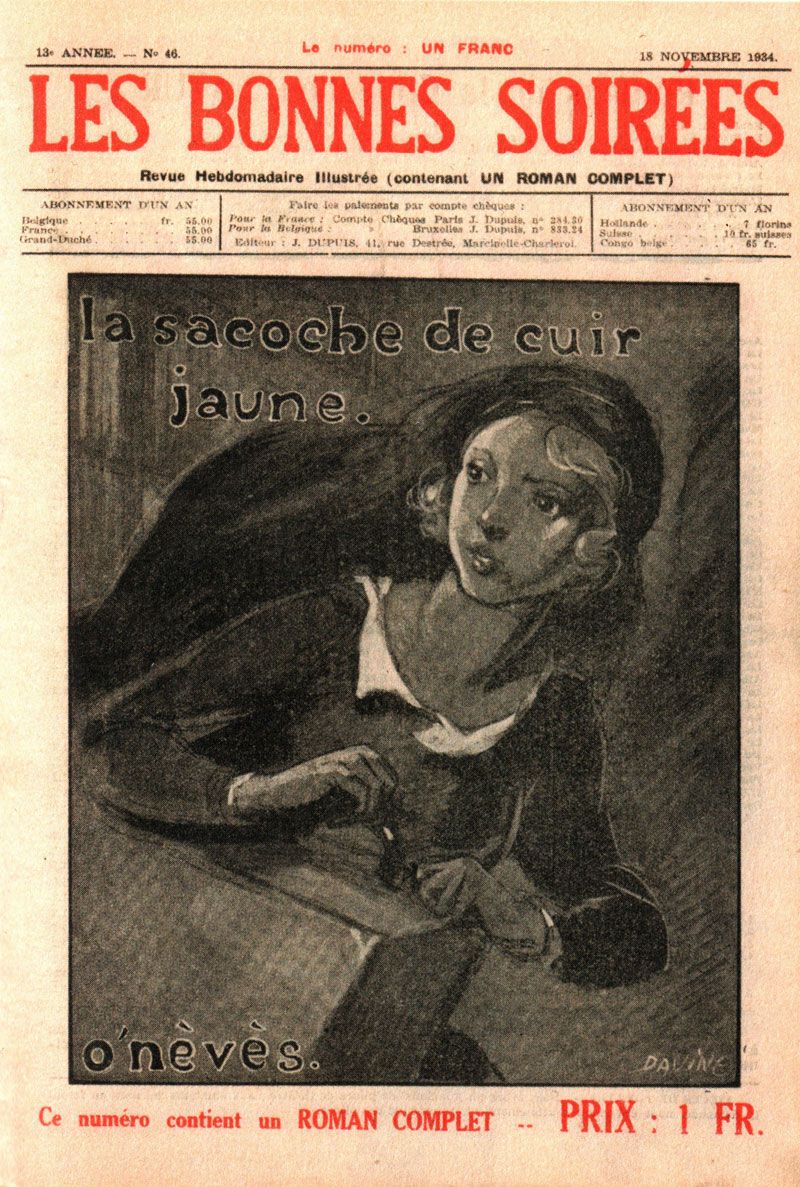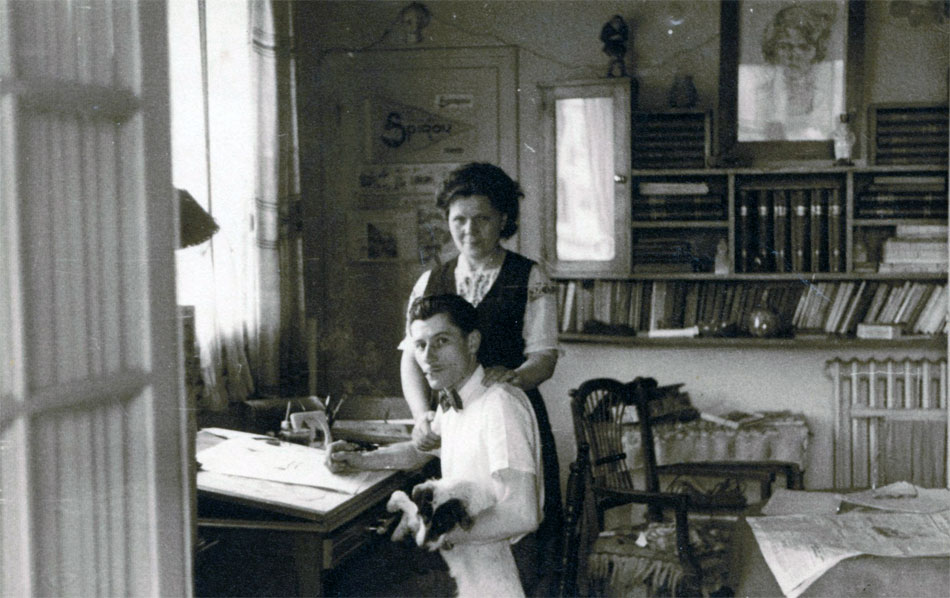'Les Aventures de Zizette' (Spirou, 14 September 1939).
Blanche Dumoulin was a Belgian comic creator and writer, and one of two people associated with the signature "Davine", the other being the painter/illustrator Luc Lafnet. Dumoulin was the wife of the French comic artist Robert Velter, most famous as the original creator of 'Spirou' (1938), mascot of the Belgian magazine of the same name. As a writer, Dumoulin helped her husband with gags and stories for his comics 'M. Subito', 'Toto' and 'Spirou'. Under the "Davine" banner, she and Lafnet created the comic serial 'Les Aventures de Zizette' (1938) in the early issues of Spirou magazine. While Dumoulin's career in comics lasted no longer than a decade and mostly in the shadow of her male colleagues, she ranks as one of the earliest female Belgian comic creators, alongside her predecessors Jeanne and Laure Hovine.
Early life and career
Blanche Dumoulin was born in 1895 in the industrial city of Liège, Belgium. In 1916, she enrolled at the local art academy, as one of the first female students. There, she became friends with Luc Lafnet, a local painter and founder of the artist group La Caque, which also had among its members the novelist Georges Simenon (of 'Inspector Maigret' fame). Joining the group, Dumoulin became close friends with Simenon's first wife Régine Ranchon, but her most lasting association was with group founder Lafnet, who worked on the side as an illustrator for popular magazines. To distinguish his commercial work from his artistic career, he chose the pen name "Davine".
For a long time, it was presumed that Blanche Dumoulin was the artist behind the signature of Davine. It wasn't until the Dupuis historians Christelle and Bertrand Pissavy-Yvernault researched the origins of the 'Spirou' comic for the 2013 books 'Spirou par Rob-Vel: L'Intégrale 1938-1943' and 'La Véritable Histoire de Spirou: 1937-1946', that the origins of the Davine name became more public knowledge. It can be safely assumed that most occurrences of the Davine signature can be attributed to Luc Lafnet.
Cover illustration for Les Bonnes Soirées of 18 November 1934, signed "Davine".
Between 1927 and 1932, Blanche Dumoulin lived in Sydney, Australia, where she worked as a nanny for the family of a doctor originally from Verviers. After returning to Belgium in 1932, Dumoulin spent some time living in Charleroi, where around 1934 she began a collaboration with the publishing house Dupuis and its magazine Les Bonnes Soirées. At the end of 1934 or the beginning of 1935, she moved to Paris, probably to join Lafnet, who was by then living as a painter and illustrator in the Montmartre area. While Lafnet arranged for her a position as editorial secretary at the newspaper Le Dimanche Illustré, she also joined her old friend in his commercial artwork. Sharing with him the pen name Davine, Dumoulin wrote the scripts of Lafnet's comics 'Bizouk et Pélik' in Le Journal de Bébé and 'Moustique Reporter' in Le Bon Point. While it is believed that she mostly acted as Luc Lafnet's agent - she approached the offices of the illustrated children's magazines in Paris with their work - it is also possible that she used the "Davine" signature for artwork of her own. The researcher Stéphane Alexandre discovered a collage of drawings by Davine from 1935, with authentic pieces of invoices mentioning the name Blanche Dumoulin. On top of that, issues of Pierrot magazine from 1934 carry the signature "B. Davine" with a different handwriting than the regular "Davine" signature in capitals. However, statements in interviews by either Dumoulin or her relatives indicate that she didn't draw herself.
On 28 October 1937, Blanche Dumoulin married the Frenchman Robert Velter (also known as Rob-Vel or Bozz), whom she also assisted on his work. She for instance helped come up with gags for his daily 'M. Subito' strips, and assisted in the creation of the title comic for the Parisian magazine Le Journal de Toto (1937-1940). For this magazine, Davine also created her own serial 'La Naissance du Colibri' (1937), as well as pantomime gag strips. Together with Rob-Vel and Luc Lafnet, Blanche Dumoulin also began a steady collaboration with the magazines and novels published by Jean Dupuis in Marcinelle, Belgium.
Illustrations from the first issue of Spirou, signed Davine (21 April 1938). The article reflects on the death of Swedish princess Astrid, who was married to King Leopold III of Belgium until she died in car accident in 1935. The man in the left circle is Leopold III, the man in the right circle is Albert I.
Journal de Spirou
Through Dumoulin, the Belgian publisher Dupuis got in touch with Robert Velter, whom they requested to create a mascot for a new children's magazine. Over the course of 1937, the Velter couple worked with the publisher in developing the character, which eventually became the bellboy Spirou. On 21 April 1938, the first issue was launched, with Spirou literally coming to life from a painter's canvas in his debut episode. Over the next couple of months, the character appeared in a variety of front page gags, in which he constantly goofs up his hotel work, angering his brutish chief of staff Entresol. By now it is known that Blanche Dumoulin wrote most of the early 'Spirou' comics, while Luc Lafnet did the lion's share of the artwork as ghost artist. As Belgians, they were more familiar with the local folklore, current affairs and national holidays that still characterized these early comics. On 27 October 1938, a Dutch-language edition of Spirou magazine was launched under the title Robbedoes. By then, Rob-Vel and his helpers switched from gag pages to longer narratives with their bellhop character, turning him into an adventurous globetrotter.
During the magazine's first year, the team of Rob-Vel, Blanche Dumoulin and Luc Lafnet provided Spirou magazine with several additional features, like the serial 'Bibot et Tribar' and the gag strip 'Babouche', creations attributed to Velter and Lafnet. The signature of Davine appeared underneath editorial illustrations, but also in the panels of the melodramatic black-and-white comic serial 'Les Aventures de Zizette' (1938-1939), a tearful story about a child stolen from her parents. Some episodes are signed with "Laf + Dav" (Lafnet + Davine), proving that Blanche Dumoulin also turned to using the Davine name. It is assumed that Dumoulin wrote the serial, and Lafnet provided the illustrations. In 1939-1940, Davine also illustrated a serialization in Spirou of the George Fronval novel 'J. Robin, Chasseur d'Images'.
Final 'Spirou' page by Davine, published on 17 October 1940.
World War II
In March 1939, Luc Lafnet turned ill, and by September of that year he had died from pancreatic cancer. Around the same time, Nazi Germany occupied Poland, while the United Kingdom declared war on Germany. Many European countries feared an escalation of this war and mobilized their citizens. Velter was one of them, stationed for six months in the Dragons Portés regiment in Saint-Quentin, Aisne, serving the French army. For a while, he continued to work on his pages, finished and inked by his wife in Paris, before she sent them to the Spirou offices in Belgium. By then, Dumoulin had fully assumed the Davine signature, and co-signed the pages with her husband, both in Spirou and in Le Journal de Toto. During this period, several art styles can be spotted in the 'Spirou' comic. It is known that Blanche Dumoulin had recruited several assistants to keep up with the workload, but the only one known by name is J. van Straelen. Some of the final Davine pages of the 'Spirou' comic have rudimentary artwork with less lively characters and few backgrounds, while some panels seem to be traced from older artwork. They were possibly produced by Dumoulin on her own, desperate to keep the work going and receive some income.
In May 1940, despite having mobilized citizens for their respective armies, Norway, Denmark, The Netherlands, Belgium and France were still surprised by a blitz Nazi invasion. Rob-Vel was wounded during the battle of Carvin, and captured by the Nazis. For months on end, Blanche Dumoulin didn't hear from her husband, while the couple's main sources of income, Le Journal de Toto and Le Journal de Spirou, had disappeared from the market due to the invasion. This forced Dumoulin to move into a small house in the nineteenth arrondissement of Paris. Their large flat near the Gare de l'Est had become too expensive.
While Spirou did return by August of that year, the war-time chaos still made it impossible for Dumoulin to send new pages from France to Belgium. For a while, the publisher used the remaining Davine pages they had in stock to secure continuation, but after that, they assigned the local Belgian artist Jijé to temporarily continue the adventures of 'Spirou'. Between October 1940 and March 1941, Jijé improvised an end to the ongoing narrative and started a new adventure of his own. By February 1941, Rob-Vel was back in civilian life, and resumed his contact with Dupuis. Between March 1941 and September 1943, he continued to work on his signature character, by now fully on his own, or perhaps with script assistance from Blanche Dumoulin. In late 1942, to be prepared for future disasters, publisher Dupuis bought the rights to the Spirou character from Rob-Vel. It turned out to be a clever precaution, since in September 1943 the Nazis banned Spirou magazine. It took more than a year when the Allied Forces liberated Belgium in September 1944, before the situation improved. In October 1944, Spirou returned to the market. As new issues rolled from the press, Dupuis reassigned Jijé to the 'Spirou' comic. After World War II, Spirou magazine grew out into one of the leading European comic magazines, while the title comic reached new heights in the hands of André Franquin.
Post-war years
Still during World War II, Blanche Dumoulin continued to work with her husband as a writer for his new comic projects. One of the stories on which she shared credit with Velter was 'Guy Voitoux: L'Homme au Gant', serialized in 1941 in Pierrot magazine. In 1946, it was published in book format in the collection Jeunesse Aventureuse by publisher Armand Fleury. This is the final comic or illustration credit that can be attributed to Blanche Dumoulin. The Davine signature was not seen again after 1940. When Rob-Vel resumed the pre-war Davine creation 'Bizouk et Pélik' (1947) in Le Journal de Bébé-Poucet, his artwork graced the panels, underlining even further that most of the Davine illustrations were in fact done by Luc Lafnet.
Blanche Dumoulin passed away from cancer in Paris in February 1975. Shortly afterwards, Robert Velter retired from comics and moved to the harbor town of Saint-Malo, Brittany, where he spent his final years until 1991.
Blanche Dumoulin, Robert Velter and their dog Presto. Photo from the Velter family archives.







